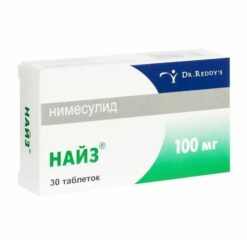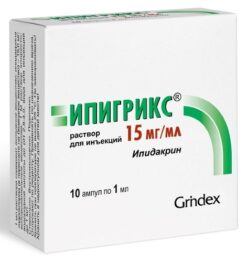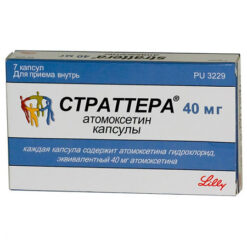-
×


-
×


-
×


Subtotal: €164.24






Subtotal: €164.24






Subtotal: €164.24
€1.00
Out of stock
(E-mail when Stock is available)
ATX:
N.05.A.L Benzamides
Pharmacodynamics:
Sulpiride is an atypical neuroleptic from the group of substituted benzamides and has moderate neuroleptic activity combined with stimulant and thymoanaleptic (antidepressant) effects. The neuroleptic effect is associated with antidopaminergic action. In the central nervous system (CNS), sulpiride blocks predominantly dopaminergic receptors of the limbic system, the effect on the neostriatal system is insignificant.
As monotherapy or in combination with other psychotropic drugs.
acute and chronic schizophrenia;
acute delirious states;
depression of various etiologies;
neurotic disorders;
dizziness of various etiologies (vertebrobasilar insufficiency, vestibular neuritis, Meniere’s disease, condition after traumatic brain injury, otitis media);
auxiliary therapy for gastric and duodenal ulcers and irritable bowel syndrome.
ATX:
N.05.A.L Benzamides
Pharmacodynamics:
Sulpiride is an atypical antipsychotic from the group of substituted benzamides, has moderate antipsychotic activity in combination with a stimulating and thymoanaleptic (antidepressive) effect. The neuroleptic effect is associated with an antidopaminergic effect. In the central nervous system (CNS), sulpiride predominantly blocks dopaminergic receptors of the limbic system; the effect on the neostriatal system is insignificant.
If hyperthermia occurs during treatment with Sulpiride Belupo should be discontinued. Hyperemia may be a sign of the development of neuroleptic malignant syndrome (manifested by hyperthermia, dyskinesia, autonomic disorders), described during treatment with neuroleptics. Although there is no data on the development of the syndrome during treatment with Sulpiride Belupo, caution is required, especially when prescribing high doses of the drug.
When prescribing Sulpiride Belupo to patients with epilepsy, a preliminary clinical and electrophysiological examination must be carried out before starting treatment, since the drug lowers the threshold for seizure activity.
Impact on the ability to drive vehicles and operate machinery
During the treatment period, driving vehicles and operating machinery that require increased attention, as well as drinking alcohol, is prohibited.
Sulpiride
1 capsule contains:
Experiments on animals did not reveal teratogenic effects.
Hypersensitivity to sulpiride or excipients of the drug
Children under 6 years of age (for 50 mg capsules)
Children under 14 years of age (for 200 mg capsules)
Prolactin-dependent tumors (pituitary prolactinomas and breast cancer)
Hyperprolactinemia
Pheochromocytoma or suspected pheochromocytoma
Acute intoxication with alcohol, hypnotics, narcotic analgesics
Breastfeeding period
Congenital galactosemia, glucose/galactose malabsorption syndrome or lactase deficiency (due to the presence of lactose in the drug)
Simultaneous use of levodopa (see section “Interaction with other drugs”)
Concomitant use of mechitazine, cabergoline, quinagolide, rotigotine, citalopram and escitalopram (see section “Interaction with other
medications”)
With caution:
In patients with a predisposition to developing cardiac arrhythmias
with bradycardia less than 55 beats per minute;
with electrolyte imbalances, in particular hypokalemia;
with congenital prolongation of the QT interval;
simultaneously receiving drugs that can cause severe bradycardia (less than 55 beats per minute); hypokalemia; slowing of intracardiac conduction or prolongation of the QT interval, since sulpiride can cause prolongation of the QT interval and increase the risk of developing severe ventricular arrhythmias, including the development of torsades de pointes (see sections “Interaction with other drugs”, “Special instructions”).
In patients with a history of neuroleptic malignant syndrome (see sections “Side effects”, “Special instructions”).
In elderly people (increased risk of sedation, orthostatic hypotension, extrapyramidal disorders).
Aggressive behavior or agitation with impulsivity (concomitant use of sedatives may be required).
In elderly patients with dementia (see section “Special instructions”).
In patients with risk factors for stroke (see section “Special instructions”).
In patients with Parkinson’s disease (see section “Special instructions”).
In patients with risk factors for the development of thromboembolism (see section “Special instructions”).
In case of diabetes mellitus and in the presence of risk factors for the development of diabetes mellitus (risk of developing hyperglycemia, blood sugar level control is required).
During pregnancy (limited experience of use) (see section “Use during pregnancy and breastfeeding”).
With epilepsy or a history of seizures (risk of lowering the seizure threshold) (see section “Special instructions”).
In case of renal failure (adjustment of the dosage regimen is required) (see section “Method of administration and dosage”).
When using medicinal products containing ethanol simultaneously (see section “Interaction with other medicinal products –
mi”).
During therapy with antipsychotics, including the drug Sulpiride Belupo, leukopenia, neutropenia and agranulocytosis were observed. The development of unexplained infections or an increase in body temperature may be signs of blood disorders, which require immediate hematological studies.
In patients with a history of glaucoma, intestinal obstruction, congenital stenosis of the digestive tract, urinary retention or prostatic hyperplasia (since the drug has m-anticholinergic properties).
In patients (especially elderly patients) with arterial hypertension due to the risk of developing a hypertensive crisis (patients should be under medical supervision).
When used in children, caution should be exercised, since the effectiveness and safety of sulpiride in this category of patients have not been sufficiently studied.
To indicate the frequency of side effects, the following classification is used, according to WHO: very common (> 1/10), common (> 1/100 and 1/1000 and 1/10000 and < 1/1000), very rare (< 1/10000), frequency unknown (cannot be calculated from the available data).Adverse events resulting from the use of sulpiride are similar to adverse events caused by other psychotropic drugs, but their incidence is generally lower.From the endocrine system: often: hyperprolactinemia.From the liver and biliary tract: often: increased activity of liver enzymes.From the nervous system: often: sedation, drowsiness, extrapyramidal disorders (these symptoms are usually reversible after the administration of antiparkinsonian drugs), parkinsonism, tremor, akathisia; uncommon: muscle hypertonicity, dyskinesia, muscular dystonia;
rarely: oculogyric crisis; frequency unknown: neuroleptic malignant syndrome, hypokinesia, tardive dyskinesia (after taking for more than 3 months, as with other antipsychotics, while taking antiparkinsonian drugs is ineffective or may provoke an increase in symptoms), seizures.
From the cardiovascular system: infrequently: orthostatic hypotension; rarely: ventricular arrhythmias, ventricular fibrillation, ventricular tachycardia; Not known: QT prolongation, torsade de pointes (TdP), cardiac arrest, sudden death, venous thromboembolic complications including pulmonary embolism and deep vein thrombosis, sometimes fatal; increased blood pressure (see section “Special instructions”).
From the genital organs and mammary glands: uncommon: breast enlargement, amenorrhea, orgasmic dysfunction, erectile dysfunction; often: breast tenderness, galactorrhea; frequency unknown: gynecomastia.
From the skin and subcutaneous tissues: often: macular-papular rash.
General disorders: often: weight gain.
From the blood and lymphatic system: uncommon: leukopenia; frequency unknown: neutropenia, agranulocytosis.
Mental disorders: often: insomnia.
From the gastrointestinal tract: uncommon: hypersalivation.
From the immune system: frequency unknown: anaphylactic reactions (urticaria, shortness of breath, excessive decrease
blood pressure, anaphylactic shock).
Musculoskeletal and connective tissue disorders: frequency unknown: torticollis, trismus.
Pregnancy, postpartum period and perinatal condition: frequency unknown: drug withdrawal syndrome in newborns (see section “Use during pregnancy and breastfeeding”).
The simultaneous use of sulpiride and drugs that depress the central nervous system (narcotic analgesics, antihistamines, barbiturates, benzodiazepines and other anxiolytics) can lead to an increase in the sedative effect of these drugs.
The combination of sulpiride with alcohol can also enhance the sedative effect of alcohol.
Concomitant administration with levodopa should be avoided due to the mutual antagonism of levodopa and sulpiride.
There is an increased risk of developing orthostatic hypotension when taking sulpiride and antihypertensive drugs simultaneously.
Sucralfate, antacids containing Mg2+ and/or Al3+ reduce bioavailability by 20-40%.
Antagonism with dopaminergic receptor agonists (amantadine, apomorphine, bromocriptine, cabergoline, entacapone, lisuride, pergolide, piribedil, pramipexole, kinagolide, ropinirole) and antipsychotics. For extrapyramidal syndrome induced by antipsychotics, dopaminergic receptor agonists are not used, but anticholinergic drugs are used. If it is necessary to treat patients with Parkinson’s disease while using dopaminergic receptor agonists, the dose of the latter should be gradually reduced until complete withdrawal (abrupt withdrawal can lead to the development of neuroleptic malignant syndrome).
The risk of developing ventricular arrhythmias of the “torsade de pointes” type when used simultaneously with: antiarrhythmic drugs of class 1a (quinidine, hydroquinidine, disopyramide) and class III (amiodarone, sotalol, dofetil, ibutilide), some antipsychotics (thioridazine, chlorpromazine, levomepromazine, trifluoperazine, cyamemazine, amisulpride, tiapride, haloperidol, droperidol, pimozide), drugs that cause bradycardia (diltiazem, verapamil, beta blockers, clonidine, guanfacine, digitalis preparations, donepizil, rivastigmine, tacrine, ambenonium chloride, galantamine, pyridostigmine, neostigmine), drugs that cause hypokalemia (potassium-sparing diuretics, some laxatives, amphotericin B IV, GCS, tetracosactide) and others (including bepridil, cisapride, difemanil, erythromycin IV, mizolastine, vincamine IV, halofantrine, pentamidine, sparfloxacin, moxifloxacin).
Symptoms (common to both dosage forms): dyskinesia (spasm of masticatory muscles, spastic torticollis), extrapyramidal disorders. In some cases – severe parkinsonism, coma.
When using tablets, the following may be observed: blurred vision, arterial hypertension, sedation, nausea, dry mouth, vomiting, increased sweating and gynecomastia, the development of NMS.
Treatment: symptomatic. Prescription of centrally acting anticholinergics.
Belupo, medicines and cosmetics d.d., Croatia
| Manufacturer | Belupo,medicines and cosmetics d.d., Croatia |
|---|---|
| Medication form | capsules |
| Brand | Belupo,medicines and cosmetics d.d. |
Buy Sulpiride Belupo, 200 mg capsules 12 pcs with delivery to USA, UK, Europe and over 120 other countries.